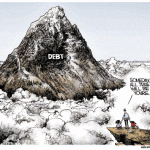Gold World News Flash |
- Poker End Game - JP Morgan, Fed, US Treasury, China & Gold
- Silver – Pushing On A String
- Gold & Politics & being a Tracker
- Marc Faber Warns "We Have Reached The Endgame Of Monetary Policy"
- When Hope Fails: Why Italian Banks Better Be Praying Draghi Can Still Do “Whatever It Takes”
- Gold Markets are not Efficient, Don?t Reflect Fundamentals & Understate Gold?s Market Value (part 1)
- CEO Of Italy's Largest Bank Surprisingly Resigns
- How The Market Reacted To Prior Government Shut Downs
- MIKE MALONEY : $2,000 or $5,000 Gold is Absurdly Low - Gold Price Will Double the Dow
- Russia Adds 12.7 Tonnes To Gold Reserves In August, Totals 1,015 Tonnes
- Silver - Pushing On A String
- GOLD Elliott Wave Technical Analysis
- SILVER Elliott Wave Technical Analysis
- What You Need to Know About the U.S. Budget Deficit & National Debt
- Marc Faber Own 25% Of His Assets In Physical Gold
- Debt Clocks Tell the Story: Vicious Upward Debt Spiral Gaining Momentum – Take a Look
- China Yaun, Renminbi: Soon to Be a World Reserve Currency?
- Did Putin Quietly Play the Debt Card Over Syria?
- Silver Price Pushing On A String
| Poker End Game - JP Morgan, Fed, US Treasury, China & Gold Posted: 29 Sep 2013 09:02 PM PDT  On the heels of continued speculation about exactly what "customers" JP Morgan is referring to that it trades for in allegedly manipulated markets, today 40-year veteran, Robert Fitzwilson, put together another tremendous piece. Fitzwilson, who is founder of The Portola Group, discusses what JP Morgan, the Fed, the U.S. Treasury and even China may really be up to and what all of this means for major markets, including gold and silver. On the heels of continued speculation about exactly what "customers" JP Morgan is referring to that it trades for in allegedly manipulated markets, today 40-year veteran, Robert Fitzwilson, put together another tremendous piece. Fitzwilson, who is founder of The Portola Group, discusses what JP Morgan, the Fed, the U.S. Treasury and even China may really be up to and what all of this means for major markets, including gold and silver.This posting includes an audio/video/photo media file: Download Now |
| Posted: 29 Sep 2013 07:30 PM PDT by Hubert Moolman, Silver Seek:
What can be noted is that the CFTC has reached the conclusion that the “alleged” manipulation by JPMorgan in the silver market, well documented and presented to the CFTC by Andrew Macguire, was much ado about nothing.. Just like lackey Eric Holder, chief law [un]enforcement official a the Dept of [no]Justice, has not been able to uncover any wrongdoing by Wall Street over the past 5 years, the CFTC ran into the same “bad luck” during its two-year investigation. |
| Gold & Politics & being a Tracker Posted: 29 Sep 2013 06:30 PM PDT by argentus maximus, TF Metals Report:
This is not an investigation in the normal sense as will become clear below. More like a presentation of some relationships which may or may not be primarily inter-causal. It's not looking at any particular presidential or royal person, but because I will use dollar based gold charts, it appears to focus upon the US. I said "appears" because …. well … what one politician does in for example the US, maybe another politician in …. oh … let's say Japan or the UK or even the EU … that other politician just might consider that thing a clever thing to do too. You know: birds of a feather and so on. |
| Marc Faber Warns "We Have Reached The Endgame Of Monetary Policy" Posted: 29 Sep 2013 04:28 PM PDT "One day this whole credit bubble will be deflated very badly - you are going to experience a complete implosion of all asset prices and the credit system..." Marc Faber was in fine form at the CLSA Investor Forum, dispensing his trademark gloom and doom. The final keynote was a tour de force of the history of debt, asset bubbles and financial markets in the 20th and 21st centuries.
In addition there has since 2007 been:
In thinking about what the next big bubble will be, Faber said:
Faber thought economists should distinguish between economic growth where credit grows at the same rate as the economy, which he believes is sound compared with a situation where credit grows faster than the economy. Credit used in capital formation is more beneficial to an economy than if used for consumption, as is the case in the US.
Advanced sign of the cracks in the system are already evident. A dollar of additional credit in the system created significant economic growth, but these days an additional dollar has very little impact.
Another indication is when the US government has to issue treasuries to pay the interest on its maturing debt.
|
| When Hope Fails: Why Italian Banks Better Be Praying Draghi Can Still Do “Whatever It Takes” Posted: 29 Sep 2013 04:00 PM PDT from Zero Hedge:
The problem for these same banks, is that while they engaged in the greatest ECB-backstopped leap of faith ever, and scrambled to buy every last piece of insolvent paper they could find, even as the host governments engaged in absolutely no structural reforms and raked up new record amounts of debt – while certainly wasting no time in blaming (f)austerity for every political failure due solely to their corruption and incompetence – the ECB had no real deus ex machina up its sleeve. |
| Gold Markets are not Efficient, Don?t Reflect Fundamentals & Understate Gold?s Market Value (part 1) Posted: 29 Sep 2013 04:00 PM PDT Gold Forecaster |
| CEO Of Italy's Largest Bank Surprisingly Resigns Posted: 29 Sep 2013 03:05 PM PDT The situation in Italy appears to be going from bad to worse. With a confidence vote pending for Tuesday as the government dissolves into chaos for the umpteenth time, and following the resignation of the CEO of one of Italy's largest non-financial corporations (Telecom Italia), the largest bank (by assets) in Italy - Intesa SanPaolo has announced - effective immediately - the resignation of its CEO and replacement with Carlo Messina. According to sources, the now former CEO had lost the confidence of shareholders (which is odd given the bank's stock is near 2-year highs). We can't help but wonder Ayn Rand-like at the devolution of the ruling class in Italy and what happens next (in light of the crumbling manufacturing and production data).
As we noted previously, things do not look so good for Italy (as a reminder the 3rd most indebted nation in the world)...
The question remains - why no tearing of the social fabric? or is this diminution of the ruling elite about to bring reality back to the masses? |
| How The Market Reacted To Prior Government Shut Downs Posted: 29 Sep 2013 02:29 PM PDT With even the most compromising politicians on both sides of the aisle admitting at least a brief government shutdown is inevitable (and according to Stone McCarthy the shutdown will hardly be brief and will affect the timely release of such major economic indicators as construction spending, factory orders and the employment number on Friday), the next question arises: how have markets responded to not only shutdowns, but also debt ceiling impasse (with the memory of August 2011 still very vivid) in the past. Here is the full answer from Deutsche's Dominic Constam.
* * * Finally, anyone who thinks they have a bearing on the political theater may be wise to reevaluate. For once, Washington's theattrical muppetry may have run out of control. From Stone McCarthy: "At this point, we don't see how this gets resolved quickly. We also don't know what the implications are for the battle over the debt limit. Some observers think linking a fight over Obamacare to the CR will allow the Tea Party to get it out of its system, so to speak, and as a result, it'll be easier to get an increase in the debt limit. We're not so sanguine. That scenario might make some sense if Senate Democrats and the White House made some concessions on the ACA in order to prevent or end a government shutdown. But right now, that doesn't seem likely. |
| MIKE MALONEY : $2,000 or $5,000 Gold is Absurdly Low - Gold Price Will Double the Dow Posted: 29 Sep 2013 10:41 AM PDT Mike Maloney: $2,000 or $5,000 Gold is Absurdly Low - Gold Price Will Double the Dow Mike Maloney of GoldSilver.com says our monetary system is doomed. Maloney contends, "It's a 100%... [[ This is a content summary only. Visit http://goldbasics.blogspot.com or http://www.newsbooze.com or http://www.figanews.com for full links, other content, and more! ]] |
| Russia Adds 12.7 Tonnes To Gold Reserves In August, Totals 1,015 Tonnes Posted: 29 Sep 2013 10:40 AM PDT It is getting kind of a cliché: the monthly gold reserve accumulation mainly by Russia and China continues non stop. The most up-to-date chart (see below, courtesy of Sharelynx) shows that Russia has been accumulating gold bullion for 6 straight years. What’s more, from a shorter term point of view, this appears to the be the 11th month of gold accumulation. Recent official data from the International Monetary Fund provided some more details, not only about Russia but also Kazakhstan and Turkey. In particular, Bloomberg notes that “Russian assets gained 12.7 metric tons to 1,015.5 tons, International Monetary Fund data showed today. Kazakhstan's reserves rose 2.5 tons to 134.5 tons and Turkey added 23.4 tons to 487.4 tons, the data showed.” Earlier this week, Marc Faber explained what’s behind the trend of PHYSICAL gold moving from West to East: “In the East, we have a tradition of owning physical gold, but what is new is the Chinese government encouraging citizens to own gold. I believe that in the face of political instability and a lack of faith in the U.S. dollar, Asians will continue to accumulate physical gold and silver.” We have written repeatedly about gold’s move from the West to the East. Read more in these articles: Gold Continues to Move from West to East: Is Yours? China's Central Bank Official Calls For New Monetary System Demand For Gold In The East Remains Explosive This Is How Gold Rush Asia 2013 Looks Like |
| Posted: 29 Sep 2013 08:52 AM PDT Little in the way of news has transpired in the past week that could have an impact on the silver market. The main stage has been set for some time, regarding all the known factors affecting silver, to date. There is no need to review ... Read More... |
| GOLD Elliott Wave Technical Analysis Posted: 29 Sep 2013 08:45 AM PDT Gold: Last analysis expected more upwards movement for Friday which is what happened. Confidence in this wave count increased with price movement above 1,332.33. The wave count remains the same. Read More... |
| SILVER Elliott Wave Technical Analysis Posted: 29 Sep 2013 07:28 AM PDT Silver: Sideways movement for the last four days looks like a combination or double flat unfolding. It would be incomplete; one more final small wave down should complete it. Read More... |
| What You Need to Know About the U.S. Budget Deficit & National Debt Posted: 29 Sep 2013 06:53 AM PDT Q: Don’t laugh at me, but what is a deficit? A: It’s actually not a dumb question. So writes Dylan Matthews (washingtonpost.com/blogs/wonkblog/) in edited excerpts from his original article* entitled Everything you need to know about the deficit. [The following article is presented by Lorimer Wilson, editor of www.FinancialArticleSummariesToday.com and www.munKNEE.com and the FREE Market Intelligence Report newsletter (sample here – register here) and may have been edited ([ ]), abridged (…) and/or reformatted (some sub-titles and bold/italics emphases) for the sake of clarity and brevity to ensure a fast and easy read. This paragraph must be included in any article re-posting to avoid copyright infringement.]Matthews goes on to say in further edited excerpts: There are plenty of deficits that federal economic policymakers have to keep track of. There’s
Do we usually have a deficit? Yes. For most of American history, we’ve been spending more than we take in, meaning we run deficits. For brief moments in the late 1960s and late 1990s we took in more than we spent, meaning we had surpluses, but surpluses are rare. How big is the deficit? The 2013 deficit is 3.9% of GDP, or 2.5% if you exclude interest payments. That works out to roughly $642 billion. Is it going up or down? The deficit’s definitely going down, as this chart from the latest CBO budget projections demonstrates, but will start growing again in a few years:
As a consequence, the debt load is expected to keep increasing:
Are the deficit and the debt the same thing? No.
How much debt do we have? Debt held by the public (that is, not held by the government itself in trust funds and the like) is about $12 trillion, or 73% of GDP. That’s lower than the UK, France, Germany, Canada, Italy, or (especially) Japan, but larger than many Nordic countries, Australia, and South Korea. Is borrowing all that money bad? Depends how much interest you’re paying. If we always paid below-inflation interest rates, then we’d be crazy not to borrow but sometimes interest rates can creep much higher. In 1984, real interest rates stopped just short of reaching 10%. That not only makes that year’s borrowing more expensive, it makes past borrowing more expensive, since debt is frequently rolled over; that is, past creditors are paid back with money borrowed from new creditors. If the rate at rollover is higher than the rate when the money was originally borrowed, then that old debt starts to cost more. Does having a lot of debt hurt growth? We don’t really know. What evidence has been marshaled for this proposition, however, is remarkably weak. The best-known evidence was provided by a working paper from Harvard’s Carmen Reinhart and Kenneth Rogoff, which argued that high debt loads (in particular loads above 90%) are correlated with slower growth. The biggest problem with this is that it’s unclear from their data whether the high debt is causing the slow growth, or if it’s the other way around. The mechanism by which high debt would hurt growth is unclear but it’s easy to see how slow growth could reduce tax revenue and increase unemployment and welfare payments, and so add on to the debt. [More recent] analyses have confirmed that the causal arrow went from slow growth to high debt, not the other way around.
The left chart [above] correlates debt-to-GDP ratios of a given year to the GDP growth rates of the next three years. If debt is causing slow growth, there should be a strong relationship but, except at the very low end, there isn’t. Meanwhile, the right chart correlates debt-to-GDP ratios of a given year to GDP growth rates of the previous three years. There’s a very strong relationship, indicating that slow growth causes high debt and not the other way around.
UMass Amherst economists Thomas Herndon, Michael Ash and Robert Pollin, however, found that Reinhart and Rogoff made a key Excel error that had the effect of overstating the correlation between slow growth and high debt.
That’s all a long way of saying that the case for high debt causing slow growth, rather than the other way around, is remarkably weak. If interest rates are very high, then a debt burden can become a serious fiscal problem but the evidence on growth doesn’t make for a strong case against adding debt. How did we get all this debt anyway? The best chart on this is the so-called ”parfait chart” by the Center on Budget and Policy Priorities (CBPP), which breaks down what specific policies caused the big increase in the U.S. federal debt in the 2000s. Strikingly, the current debt was almost entirely caused by events in the past 13 years. [As the "parfait chart" below illustrates,] the most important factor was the Bush tax cuts of 2001 and 2003, which greatly reduced federal revenues and put the federal government into deficit after the surpluses of the late ’90s and early ’00s, but the economic downturn, the stimulus and other recovery measures, and the wars in Iraq and Afghanistan all played important roles too. Without those four things, we’d have a debt burden around 20% of GDP — far too small to even start to worry about, and smaller than every developed country other than Luxembourg:
What’s driving that increase? It’s not that revenues are falling; in fact, they’re growing over the medium-term. The cause is an increase in spending – one that’s concentrated, overwhelmingly, on health care, with some Social Security thrown in. [As outlined in the table below,] Federal spending on major health-care programs was 4.6% of GDP in 2013, up from an average of 2.7% from 1973 to 2012. By 2038, it’s projected to increase to 8.0%. Spending on Social Security, currently 4.9% of GDP, will grow to 6.2% by 2038.All other spending will fall from 10.0% to 7.1% but because the debt load is growing, the cost of servicing it will grow from 1.3% to 4.9%.
I’ve heard people say we need to “stabilize the debt.” What would that take? A bit, but not a whole lot. CBPP estimates [in Figure 1 below] that, now that the Budget Control Act (aka the debt ceiling deal, including sequestration) and the American Taxpayer Relief Act (aka the fiscal cliff deal, including the partial expiration of the Bush tax cuts) are in effect, it’d only take another $1.5 trillion in deficit reduction over ten years to stabilize the debt load.
[Editor's Note: The author's views and conclusions in the above article are unaltered and no personal comments have been included to maintain the integrity of the original post. Furthermore, the views, conclusions and any recommendations offered in this article are not to be construed as an endorsement of such by the editor.]*http://www.washingtonpost.com/blogs/wonkblog/wp/2013/09/19/everything-you-need-to-know-about-the-deficit/?wprss=rss_economy (© 1996-2013 The Washington Post) Related Articles: 1. The Great American Debt Downgrade Debacle That Wasn't!
It's been over two years since Standard & Poor's did the unthinkable and downgraded the U.S. government's debt rating…and yet, it's as if it never happened… Read More » 2. Direction of U.S. Trade Deficit Indicates Direction of U.S. Dollar
The trade deficit has improved a lot since 2010 and the U.S. dollar strengthened with it but I believe that is all about to change. Here’s why. Read More » 3. Debt Clocks of the U.S., U.K., Canada, Australia & the World A BIS study released in June 2012 warns that budgets of most advanced economies, excluding interest payments, “would need 20 consecutive years of surpluses exceeding 2 per cent of gross domestic product – starting now – just to bring the debt-to-GDP ratio back to its pre-crisis level”. Read More » 4. How Likely Is the Fed to Go Bust & What Would it Mean For YOU? At this point, thanks to a long-standing policy of wanton money printing, the Fed has more liabilities than ever before in its history – by an enormous margin – and this precarious balance sheet is dangerous, because if the Fed goes bust, everyone loses [- including YOU. Let me explain why that is the case]. Words: 398 Read More » 5. Rapid Rise In Interest Rates Will Collapse U.S. Financial System – Here's Why
There is one vitally important number that everyone needs to be watching right now, and it doesn't have anything to do with unemployment, inflation or housing. If this number gets too high, it will collapse the entire U.S. financial system. The number that I am talking about is the yield on 10 year U.S. Treasuries. Here's why. Words: 1161; Charts: 2 Read More » 6. Economics Can't Trump Mathematics & the Math Says US In a Debt Death Spiral The madmen who are responsible for the coming economic disaster continue to behave as if they can manage to avoid it. Violating Einstein's definition of insanity, they continue to apply the same poison that caused the problem. These fools believe they can manage complexities they do not understand. We are bigger fools for providing them the authority to indulge their hubris and wreak such damage. Read More » Anyone that thinks that the U.S. economy can keep going along like this is absolutely crazy. We are in the terminal phase of an unprecedented debt spiral which has allowed us to live far, far beyond our means for the last several decades. Unfortunately, all debt spirals eventually end, and they usually do so in a very disorderly manner. Read More » 8. Why the End of This Economic Death Spiral Is So Hard to Call Whether you are an investor, concerned citizen or merely someone trying to understand the current economic situation, you should be worried. Watch this video to get an outstanding overview of what is occurring. It is probably the best short explanation as to why the end of this economic death spiral is so hard to call. Rea |
| Marc Faber Own 25% Of His Assets In Physical Gold Posted: 29 Sep 2013 06:39 AM PDT Sprott Resources organized an online round table. Several leading investors voiced their opinion about the ongoing economic evolution, central planning policies and precious metals. The webcast is open for everyone after registration. Attendees at the round table were Marc Faber, publisher of the economic and financial report Gloom, Boom and Doom Report; John Embry, Sprott Asset Management Chief Investment Strategist; Rick Rule Sprott, Global Resource Investments Founder; Eric Sprott, Sprott Asset Management Founder. In this article, our focus is on Marc Faber’s points of view. The following are several quotes from the round table. Faber about the recent announcement of the US Federal Reserve regarding tapering:
Faber explains the massive gold accumulation by China, India and Russia:
Faber justifies the share of precious metals in his total portfolio:
Register for the webcast for full access to the round table (highly recommended). |
| Debt Clocks Tell the Story: Vicious Upward Debt Spiral Gaining Momentum – Take a Look Posted: 29 Sep 2013 06:31 AM PDT A vicious upward debt spiral is gaining momentum. The budgets of most advanced economies, As accessed from Wikipedia, according to the Bank for International Settlements, if only one of the following three events were to occur, the increased financial burden imposed by ageing populations and lower growth would make it very unlikely that indebted economies would be able to grow out of their debt problem:
The Boston Consulting Group (BCG) adds that if the overall debt load continues to grow faster than the economy, then large-scale debt restructuring becomes inevitable. To prevent a vicious upward debt spiral from gaining momentum the authors urge policy makers to:
Source: Wikipedia To see an up-to-the-second visual of the debt picture visit the links below: 1. World (by country): http://www.usdebtclock.org/world-debt-clock.html 2. U.S.A.: http://www.usdebtclock.org/ 3. Canada: http://www.nationaldebtclocks.org/debtclock/Canada 4. U.K.: http://www.nationaldebtclocks.org/debtclock/unitedkingdom 5. Australia: http://www.nationaldebtclocks.org/debtclock/australia Related articles: 1. What You Need to Know About the U.S. Budget Deficit & National Debt Q: Don’t laugh at me, but what is a deficit? A: It’s actually not a dumb question. Here’s why. Read More » The Ponzi bubble is bigger than most can imagine. Western central planners… [continue to try to] suppress gold and silver in order to keep their sorry lives alive. In the process, the destruction of people's financial well- being is unabated… Read More » 3. When the Debt Bubble Bursts We're Going to See Economic Chaos So Get Ready – NOW! Never before has the world faced such a serious debt crisis. Yes, in the past there have certainly been nations that have gotten into trouble with debt, but we have never had a situation where virtually all of the major powers around the globe were all drowning in debt at the same time. Right now, confidence is being shaken as debt levels skyrocket to extremely dangerous levels. Many are openly wondering how much longer this can possibly go on. [Here's my take on the situation.] Read More » At this point, thanks to a long-standing policy of wanton money printing, the Fed has more liabilities than ever before in its history – by an enormous margin – and this precarious balance sheet is dangerous, because if the Fed goes bust, everyone loses [- including YOU. Let me explain why that is the case]. Words: 398 Read More » 5. Rapid Rise In Interest Rates Will Collapse U.S. Financial System – Here's Why
There is one vitally important number that everyone needs to be watching right now, and it doesn't have anything to do with unemployment, inflation or housing. If this number gets too high, it will collapse the entire U.S. financial system. The number that I am talking about is the yield on 10 year U.S. Treasuries. Here's why. Words: 1161; Charts: 2 Read More » 6. Economics Can't Trump Mathematics & the Math Says US In a Debt Death Spiral The madmen who are responsible for the coming economic disaster continue to behave as if they can manage to avoid it. Violating Einstein's definition of insanity, they continue to apply the same poison that caused the problem. These fools believe they can manage complexities they do not understand. We are bigger fools for providing them the authority to indulge their hubris and wreak such damage. Read More » Anyone that thinks that the U.S. economy can keep going along like this is absolutely crazy. We are in the terminal phase of an unprecedented debt spiral which has allowed us to live far, far beyond our means for the last several decades. Unfortunately, all debt spirals eventually end, and they usually do so in a very disorderly manner. Read More » 8. Why the End of This Economic Death Spiral Is So Hard to Call Whether you are an investor, concerned citizen or merely someone trying to understand the current economic situation, you should be worried. Watch this video to get an outstanding overview of what is occurring. It is probably the best short explanation as to why the end of this economic death spiral is so hard to call. Read More » 9. Lessons of 2008 Forgotten – Debt Threatens to Undo the World Again Little has been done in the past six years to restructure economies and cut debt i.e. learn the lessons of 2008. Because we've partially recovered from that traumatic period, that's led to complacency. All the while, the debt that caused the bust in the first place has compounded and threatens to undo the world again. Let's hope it doesn't come to that. Read More » 10. Another Crisis Is Coming & It May Be Imminent – Here's Why Is there going to be another crisis? Of course there is. The liberalised global financial system remains intact and unregulated, if a little battered…The question therefore becomes one of timing: when will the next crash happen? To that I offer the tentative answer: it may be imminent…[This article puts forth my explanation as to why that will likely be the case.] Read More » 11. Japan: A Country On the Brink of Fiscal & Economic Disaster! I wrote several years ago that Japan is a bug in search of a windshield and in January I wrote that 2013 is the Year of the Windshield. Japan is a country that is on the brink of fiscal and economic disaster Read More » 12. "Ponzi Finance": What Must Happen To Bring It To An End? The Boston Consulting Group has issued a paper that recommends 10 steps that developed countries must take to end what they refer to as 'Ponzi finance' and to return to a sustainable growth path but I believe their recommendations to be but theoretical and impractical constructs. While I believe we face – and will experience – interesting, speculative, fragile, and very challenging and very likely life-changing times going forward, I believe that the only thing that will force developed country politicians to work for common purposes is a further global financial crisis. This article provides an overview and assessment of said paper and the rationale for my position. Words: 600 13. Gov't Debt Will Keep Increasing Until the System Implodes! Are You Ready? Why are so many politicians around the world declaring that the debt crisis is "over" when debt-to-GDP ratios all over the planet continue to skyrocket? The global economy has never seen anything like the sovereign debt bubble that we are experiencing today. This insanity will continue until a day of reckoning arrives and the system implodes. Nobody knows exactly when that moment will be reached, but without a doubt it is coming. Are you ready? Words: 1270 |
| China Yaun, Renminbi: Soon to Be a World Reserve Currency? Posted: 29 Sep 2013 01:49 AM PDT I get the question all the time: when will the Chinese renminbi (RMB) replace the US dollar as the major world reserve currency? The assumption behind such questions is almost always that the coming crisis in US entitlement programs will force the Fed to monetize even more debt, thereby killing the dollar. Or some derivative line of that thought. Contrary to the thinking of fretful dollar skeptics, my firm belief is that the US dollar is going to become even stronger and will at some point actually deserve to be the reserve currency of choice rather than merely the prettiest girl in the ugly contest – the last currency standing, so to speak. |
| Did Putin Quietly Play the Debt Card Over Syria? Posted: 29 Sep 2013 01:26 AM PDT "They are living beyond their means and shifting a part of the weight of their problems to the world economy. They are living like parasites off the global economy and their monopoly of the dollar. If [in America] there is a systemic malfunction, this will affect everyone. Countries like Russia and China hold a significant part of their reserves in American securities. There should be other reserve currencies." – Vladimir Putin in 2011 |
| Silver Price Pushing On A String Posted: 29 Sep 2013 01:21 AM PDT Little in the way of news has transpired in the past week that could have an impact on the silver market. The main stage has been set for some time, regarding all the known factors affecting silver, to date. There is no need to review any of them, at this point. What can be noted is that the CFTC has reached the conclusion that the “alleged” manipulation by JPMorgan in the silver market, well documented and presented to the CFTC by Andrew Macguire, was much ado about nothing.. Just like lackey Eric Holder, chief law [un]enforcement official a the Dept of [no]Justice, has not been able to uncover any wrongdoing by Wall Street over the past 5 years, the CFTC ran into the same “bad luck” during its two-year investigation. |
| You are subscribed to email updates from Save Your ASSets First To stop receiving these emails, you may unsubscribe now. | Email delivery powered by Google |
| Google Inc., 20 West Kinzie, Chicago IL USA 60610 | |



 Little in the way of news has transpired in the past week that could have an impact on the silver market. The main stage has been set for some time, regarding all the known factors affecting silver, to date. There is no need to review any of them, at this point.
Little in the way of news has transpired in the past week that could have an impact on the silver market. The main stage has been set for some time, regarding all the known factors affecting silver, to date. There is no need to review any of them, at this point. Are there political cyclical tracks left behind in the price of inflation defense assets like for example gold?
Are there political cyclical tracks left behind in the price of inflation defense assets like for example gold? When back in July 2012 Mario Draghi, on the verge of yet another Eurozone collapse, promised the world that he would do literally “whatever it takes” to defend the Euro, banks in the insolvent continent took his promise seriously, and ramped up their participation in the most epic Ponzi scheme conceived in Europe to a whole new level. The scheme, of course, was one where banks would buy sovereign bonds issued by their host country (most notably Spain and Italy), and subsequently repo them back to the ECB for near full cash (net of a minuscule haircut) collateral.
When back in July 2012 Mario Draghi, on the verge of yet another Eurozone collapse, promised the world that he would do literally “whatever it takes” to defend the Euro, banks in the insolvent continent took his promise seriously, and ramped up their participation in the most epic Ponzi scheme conceived in Europe to a whole new level. The scheme, of course, was one where banks would buy sovereign bonds issued by their host country (most notably Spain and Italy), and subsequently repo them back to the ECB for near full cash (net of a minuscule haircut) collateral. 


























No comments:
Post a Comment